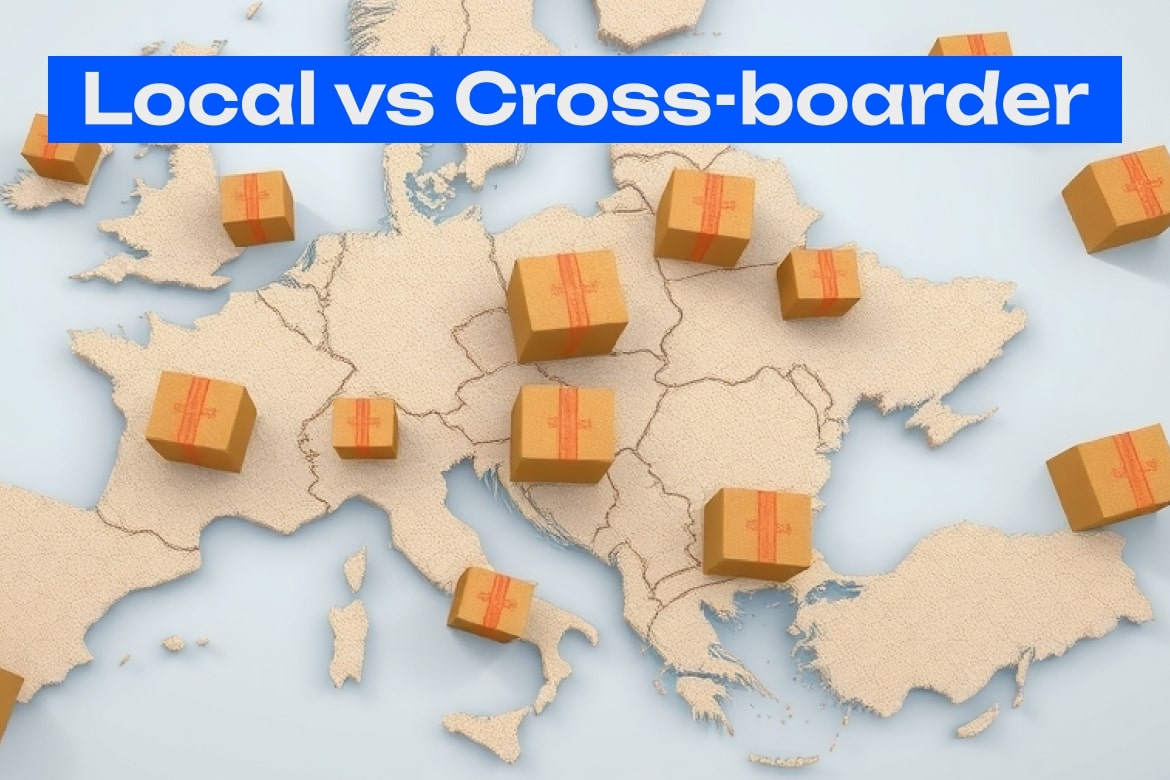Is local always better? When cross-border fulfillment wins
Written by
Editorial TeamPublished on
Think local is always better for e-commerce fulfillment? Discover how cross-border shipping can be faster, cheaper, and smarter — especially within the EU. (Ad)

Commercial collaboration
In the world of e-commerce logistics, the belief that “closer is better” has long influenced fulfillment decisions. Sellers assume that fulfilling orders from within the destination country, such as using a fulfillment center in Germany, will always be faster, cheaper, and more efficient. While this is sometimes true, it’s not a universal rule.
In reality, the smartest logistics decisions today aren’t based solely on geography. Instead, they hinge on strategy, technology, and cost-efficiency. With the rise of cross-border fulfillment services, brands can ship quickly and affordably from warehouses outside the target country, often reaping major savings and operational benefits in the process.
In this article, we dive into when and why cross-border fulfillment can outperform local solutions, using insights from WAPI, a fulfillment, marketplace, and courier aggregator with a strong presence across Europe, including in Slovakia and Germany.

What is cross-border fulfillment?
Cross-border fulfillment refers to storing products in one country and shipping them to customers in another. Unlike local fulfillment, where inventory is kept and distributed within the same country, cross-border models allow merchants to centralize stock and serve multiple countries from a single location.
With modern supply chain technology and fulfillment software, cross-border logistics has evolved into a highly efficient option, particularly within the European Union where open borders and unified regulations make it smooth and cost-effective.
Common misconceptions about cross-border fulfillment
While cross-border fulfillment might sound slower or more complex, many of these concerns are outdated. Let’s debunk a few common myths:
Myth 1: It’s always slower.Modern courier networks, last mile delivery tracking, and fast routes within the EU allow deliveries in 1–2 days, even across borders.
Myth 2: It’s more expensive.Shipping and storage costs can actually be lower, especially when warehousing in countries with lower operational costs.
Myth 3: Customs delays are inevitable.Within the EU, goods move freely. Even outside the EU, systems like EORI numbers and digital customs forms reduce processing times.
Why cross-border fulfillment sometimes wins
1. Lower operational costs
Operating in high-cost countries like Germany can drive up storage and labor expenses. By warehousing in countries like Slovakia, businesses can cut costs by 20–30%.
WAPI’s fulfillment center in Slovakia provides one such example. Storage, picking, and packing costs are significantly lower, and yet delivery to German customers remains fast and reliable. Businesses taking advantage of this structure often report overall cost reductions of up to 35% when switching from local to cross-border fulfillment.
These savings don’t come at the cost of customer experience. With proper software and courier integration, end customers often don’t even realize their orders originated outside the country. What’s more, the lower cost base allows merchants to reinvest in marketing, customer service, or expanding product lines.
2. Fast delivery across borders
WAPI’s Slovakian warehouse services Germany with average delivery times of 1.5 to 2 days. Bratislava to Munich is less than 500 km, and regional courier pricing often treats this route as local or semi-local. The proximity allows for efficient routes and competitive pricing that match or even beat local distribution.
With real-time tracking and optimized last mile delivery tracking, cross-border shipments are virtually indistinguishable from domestic ones for the end customer. In fact, in WAPI’s internal tracking, more than 87% of cross-border shipments to Germany arrive within the same time window as local German shipments.
When paired with services like Amazon preparation service, merchants can even benefit from automated labeling, bundling, and marketplace compliance, all handled cross-border.
3. Unified EU regulations
Since Slovakia and Germany are both part of the EU, no customs duties apply, and documentation is minimal. A valid EORI number is typically all that’s needed. This ensures smooth transit and reliable delivery windows.
WAPI’s fulfillment software ensures this documentation is automatically prepared, streamlining First Mile Delivery and reducing error rates. Automated systems flag discrepancies before shipping, ensuring compliance without delays.
The Single Market advantage in Europe means sellers can leverage lower-cost regions without facing trade barriers. This has been particularly valuable post-COVID, as supply chain resilience has become a top priority.
4. Better scalability
Cross-border fulfillment offers businesses more flexibility. For example, a seller launching in Germany may test demand by shipping from Slovakia before committing to long-term warehouse leases in the country.
This model also makes it easier to scale across borders without duplicating stock or increasing logistics complexity. Centralized models also support easy expansion into additional markets, Austria, Czechia, and Hungary are all reachable within 1–2 days from WAPI’s Slovak hub.
It also allows brands to shift inventory quickly based on seasonal demand or performance. With centralized software, rebalancing inventory is just a few clicks away.
5. Centralized inventory management
Using WAPI’s centralized fulfillment software, sellers can manage inventory across multiple warehouses, including in Slovakia, Germany, and the UK. The system automatically assigns orders to the most efficient warehouse based on customer location, inventory availability, and cost.
This reduces the need for buffer inventory in each market, improving cash flow and GMROI in retail. Brands save on capital tied up in inventory and can allocate stock dynamically depending on seasonal demand or promotion performance.
Additionally, WAPI’s system provides real-time analytics, allowing brands to identify which SKUs perform best in which regions, leading to smarter forecasting and purchasing decisions.
Real-world insight: Germany from Slovakia
Let’s look at an anonymized example:
A health and wellness brand selling supplements and vitamins considered storing products in a fulfillment center in Germany. However, after comparing costs with WAPI’s Slovakian facility, the brand chose the latter.
Here’s why:
- No customs duties applied, as both countries are in the EU.
- Fulfillment costs (storage, pick & pack) were 28% lower.
- Delivery times were similar, 1.7 days on average.
WAPI provided all-in-one 3PL solution with marketplace SEO support, helping the brand boost discoverability on Amazon and other platforms.
This approach proved so successful that the brand now uses WAPI’s network to serve Austria and Czechia from the same warehouse, reducing split shipments and improving cost-efficiency. This not only streamlined operations but significantly improved customer satisfaction scores by 14% due to faster and more reliable delivery.
The brand also benefited from WAPI’s Amazon preparation center in the UK, enabling seamless entry into new markets beyond Germany.
Local fulfillment still has its place
There are certainly situations where local fulfillment is the best choice:
- Ultra-fast delivery promises (same-day or next-day by morning)
- Large, bulky, or DIM weight sensitive items that benefit from shorter transit
- Cash on delivery (still common in some regions), which may require local bank integration
- Customer perception where a “local presence” builds trust
In such cases, WAPI also operates fulfillment centers in Germany and other key markets, ensuring merchants always have the option for true local fulfillment. WAPI’s flexible network allows seamless switching or hybrid setups, combining local and cross-border advantages.
When to choose cross-border over local
Here’s a decision matrix for choosing between local and cross-border fulfillment:
| Consideration | Local Fulfillment | Cross-Border Fulfillment |
| Operational Costs | Higher | Lower in many cases |
| Delivery Speed | Fastest | Comparable (1–2 days) |
| Inventory Efficiency | Requires stock duplication | Centralized stock |
| Entry into New Market | Higher investment | Lower risk, flexible |
| Regulatory Complexity | Low | Low within EU |
| Fulfillment Scalability | Medium | High |
How WAPI supports strategic fulfillment
WAPI is not just a fulfillment service provider. It’s a tech-driven logistics partner that combines fulfillment, marketplace integration, and courier aggregation into a single streamlined platform.
Key benefits include:
1. Access to Amazon preparation service across locations
Facilities like the Amazon preparation center in Germany and Amazon preparation center in the UK
2. Dynamic routing of orders for cost and speed optimization
Full integration with marketplaces and payment systems, including those offering cash on delivery
3. Automated shipping rules that prevent split shipments and reduce packaging waste
Integration with green initiatives, including carbon neutral shipping
4. Real-time DIM weight calculation for cost-optimized packaging
By leveraging this ecosystem, brands gain better control over distribution, customer experience, and overall logistics strategy.

Future-proofing your fulfillment strategy
As e-commerce becomes more global, merchants need flexibility. Relying solely on local fulfillment can limit scalability and increase costs. The smartest brands are those that blend local and cross-border solutions, choosing the best warehouse for each product and market.
WAPI’s fulfillment software and international warehouse network help brands adapt to shifting customer expectations, marketplace rules, and shipping economics. Whether you’re looking to test a new region or scale a fast-growing market, WAPI makes sure your logistics work for, not against, you.
The future belongs to agile, data-driven logistics. Centralized systems, tech-powered operations, and location-flexible fulfillment give brands an edge over those relying on outdated local-only strategies.
Final thought
Cross-border fulfillment isn’t a workaround, it’s often a competitive advantage. By evaluating all logistics options, sellers can discover surprising efficiencies and scale smarter.
WAPI’s goal is always the same: make fulfillment as efficient, flexible, and cost-effective as possible. Whether it’s via a local warehouse or strategic cross-border delivery, we help brands choose the smartest route to growth.
***


